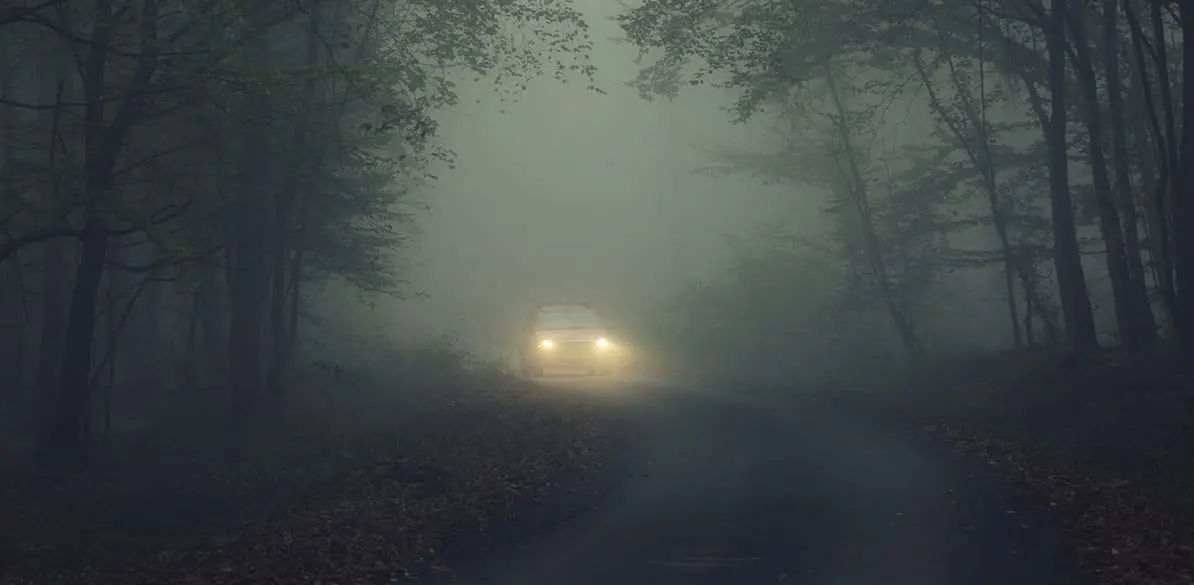Reduced visibility when driving and eyelid movement

Reduced visibility
Fog reduced horizontal visibility. Its presence prevents us from seeing distant objects and blurs the contours of nearby objects. If we add to this the presence of nearby smoke, fog can be very dangerous.
Visibility, to see and be seen, should be increased by turning on the low beam and fog lights. The high beams should not be used because the reflection of light on the suspended water drops will make vision even more difficult.
It is recommended to reduce speed and increase the distance to the vehicle ahead so that if anything unexpected happens we can stop our vehicle within the space where this is visibility.
This will prevent chain collisions, which are very dangerous in these conditions. It is also very likely that the fog will increase the chance of “skidding” if we slam on the brakes and that we will not be able to see what is happening ahead of the vehicle that is in front of us.
Obviously, this should not oblige us to drive at an extremely slow speed, but in this, as in all cases, it’s always best to act on the side of safety.
We should turn on the windshield wipers occasionally and keep the interior well ventilated so that the windows do not fog up.
Passing is especially dangerous and should not be attempted until there is sufficient visibility ahead. In addition, even in this case, we could find that a vehicle coming in the opposite direction with its lights out is literally on top of us.
Rain reduces visibility to an increasing greater extent, the smaller the drops are, and therefore drizzle is more dangerous than heavy rain with large drops.
Rain causes an additional loss of visibility from distortion of the headlights, the splashes from the vehicle ahead of us, and increased glare.
Snow reduces direct visibility, especially when the wind or even the movement of air when another vehicle passes by us causes swirls of snow that obstruct our vision.
Visual performance is much lower in snow because light contrasts are reduced. Occasionally, we can lose sight of the edges of the road and cannot distinguish the road signs.
Tips
- If rain is heavy, do not forget to turn on the dipped lights, rather than to see better, for others to see us. For the same reason, if it difficult for others circulating behind us to see us, we should also turn on the rear fog lamps.
- With fog, the dipped lights and fog lamps should be turned on do not turn on the headlights, reduce speed adjusting it to the visual field created, and increase the distance from the previous vehicle. Pay utmost attention turning off the ratio and setting up a silent.
- In adverse climatological conditions, speed should be reduced, increasing the safety distance and improving visibility with lights.
Eyelid motility
Ptosis is an abnormally low position of the upper eyelid, which can also reduce visibility. The lid normally covers 2 mm of the cornea, and therefore a ptosis of 4 mm or greater is considered serious due to the resulting reduced visibility.
Eyelid ptosis may be congenital or acquired, and aponeurotic, mechanical, neurogenic due to 3rd cranial nerve palsy, oculosympathetic in Horner’s syndrome, or synkinetic in Marcus-Gunn syndrome, in which movement of the lower jaw caused decreased or increased ptosis.
In addition, it may be myogenic and congenital or acquired as in myasthenia gravis, myotonic dystrophy and external ophthalmoplegia.
If ptosis does not affect the pupillary area, it will not alter vision or visual field, and the driver will not have to adopt compensatory positions such as hyperextension of the head and raising of the eyebrows.
Lagophthalmos, due to the impossibility of complete eyelid closure, has the secondary risk of exposure keratopathy, present in cases of facial palsies, with corneal ulceration that can leave scars altering visual acuity.
Inversion (entropion) and eversion (ectropion) of the eyelid can result from aging or scar formation.
Entropion causes irritation as the lashes rub against the eye globe and may cause corneal ulceration. Ectropion causes poor drainage of tears and may lead to redness and irritation.
Both are largely incapacitating for driving, and in both cases, surgery improves the clinical picture and the ability to drive.
Substance that induce depression of the central nervous system, such as alcohol, barbiturates, anxiolytics, cocaine, marihuana or heroin, may also cause a reduced rate and/or amplitude of blinking, modifying the mechanism of distribution of the tear film.
This is necessary for correct exchange of oxygen and metabolites in the cornea and its absence causes corneal irritation and severe ocular fatigue.
Tips
- Individuals with ptosis or lagophthalmos can ask their ophthalmologist about their influence on visual capacity, and with the report issued, as, for driving license.
- The surgical correction of ptosis and lagophthalmos invalidates the limitations existing to that time in the driving license.
- We should warn our patients, if drivers, of the side effects of some drugs on eyelid movement and its risk when driving.
- It is not permitted to drive after taking alcohol or abuse drugs.
